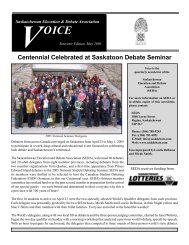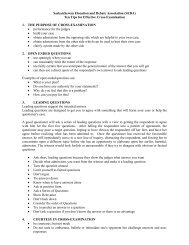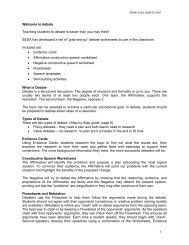Human Cloning - Saskatchewan Elocution and Debate Association
Human Cloning - Saskatchewan Elocution and Debate Association
Human Cloning - Saskatchewan Elocution and Debate Association
You also want an ePaper? Increase the reach of your titles
YUMPU automatically turns print PDFs into web optimized ePapers that Google loves.
Brave New World Page 4 of 5<br />
Smithsonian, December 2001<br />
have been recent reports of<br />
human babies who have genetic<br />
material from three adults, due<br />
to a technique that uses healthy<br />
mitochondria from a donor's egg<br />
to enhance fertility.) So, though<br />
Dolly resembled her DNA<br />
donor, other sheep that Wilmut<br />
<strong>and</strong> his colleagues have cloned<br />
vary in appearance <strong>and</strong><br />
temperament from their DNA<br />
donors as well as from other<br />
clones developed from the same<br />
DNA.<br />
It is also important to note that<br />
Dolly was born only after more<br />
than 200 other clones were<br />
spontaneously aborted or<br />
stillborn. Attempts to clone<br />
animals since have often<br />
resulted in severe birth defects<br />
— from dramatically increased<br />
birth size to enlarged organs to<br />
immune deficiencies. Going<br />
back to the blueprint analogy,<br />
Cornell professor <strong>and</strong> cloning<br />
expert Jonathan Hill adds, "It<br />
seems the cloned DNA is not<br />
only a 'used' blueprint but one<br />
that may have certain pages<br />
stuck together, making some of<br />
the details particularly hard to<br />
read."<br />
As a result of these <strong>and</strong> other<br />
factors, many scientists — <strong>and</strong><br />
politicians — believe there<br />
should be a ban on human<br />
cloning. Others are wary that<br />
such a ban might be too<br />
restrictive, since some<br />
techniques used in cloning are<br />
also used in other promising<br />
areas of science — including<br />
applications of IVF technology<br />
<strong>and</strong> stem cell research.<br />
STEM CELL RESEARCH<br />
<strong>Cloning</strong> <strong>and</strong> stem cell research<br />
are connected in at least one<br />
important way. Every one of the<br />
trillions of cells in our bodies<br />
(including our eggs <strong>and</strong> sperm,<br />
which have but one set instead<br />
of two) contain the same DNA.<br />
The cells in your skin, for<br />
example, contain the same gene<br />
for producing insulin as those in<br />
certain regions of your pancreas,<br />
but only the latter actually make<br />
the protein. Most of the genes in<br />
our cells are inactive, leaving<br />
only the relevant ones to do<br />
their work. Though we know<br />
little about how this occurs, we<br />
do know that there is a period<br />
early in development when the<br />
cells have yet to begin the<br />
processes of determination <strong>and</strong><br />
differentiation into blood,<br />
muscle or any other kind of cell,<br />
<strong>and</strong> all cells can still develop<br />
into any cell in the adult. In<br />
humans, this property — called<br />
pluripotency — is lost by the<br />
end of the second week after<br />
fertilization.<br />
Part of what made Wilmut's<br />
success with Dolly so<br />
extraordinary was that he seems<br />
to have been able to revert an<br />
adult sheep cell back to its<br />
pluripotent state (though with<br />
all of the unexplained<br />
complications we've already<br />
detailed). Other techniques are<br />
being pursued for isolating adult<br />
stem cells — cells that are only<br />
partially differentiated — <strong>and</strong><br />
reverting them to a pluripotent<br />
state, or nudging them to<br />
develop in particular directions.<br />
In the meantime, there is<br />
another source of pluripotent<br />
cells: the embryo itself.<br />
Pluripotent cells from human<br />
embryos are the embryonic stem<br />
cells at the center of last<br />
summer's debate.<br />
Much of that continuing debate<br />
centers on the fact that human<br />
embryonic stem cells are<br />
obtained, almost exclusively,<br />
from embryos left over from<br />
IVF. Though proponents of<br />
research on them point out that<br />
they would be destroyed<br />
anyway, many opponents<br />
believe that these embryos,<br />
though comp0sed of just a few<br />
dozen cells, are human lives,<br />
<strong>and</strong> so should be saved.<br />
The other reason that stem cells<br />
have burst into the news has to<br />
do with their exceptional<br />
promise. Scientists have learned<br />
to culture human embryonic<br />
stem cells <strong>and</strong> allow them to<br />
divide <strong>and</strong> multiply, while<br />
preventing them from switching<br />
on or off any of their genes. By<br />
exposing these stem cells to<br />
different molecular compounds,<br />
they are trying to underst<strong>and</strong><br />
how that switching process<br />
works so that they can direct<br />
this cell to become a neuron,<br />
say, or that one to become a<br />
blood cell. (These two<br />
examples, in fact, are feats at<br />
which they have already had<br />
some measure of success.)<br />
Eventually, some believe, we<br />
may be able to control the<br />
development of these<br />
pluripotent cells so that we can<br />
replace tissues damaged by<br />
disease or accident. Nerve cells<br />
damaged by Parkinson's or<br />
spinal cord injury, for example,<br />
or heart tissue of cardiac<br />
patients, might ultimately be<br />
replaced by tissue grown from<br />
stem cells.<br />
Some scientists see even the<br />
potential to create custom-made<br />
tissue by using stem cells that<br />
are exact matches to a particular<br />
person, thus obviating the<br />
greatest problem in transplant<br />
surgery — rejection of the<br />
implant by the host's immune<br />
system. "Therapeutic cloning,"<br />
as this procedure has been<br />
called, would involve inserting a





